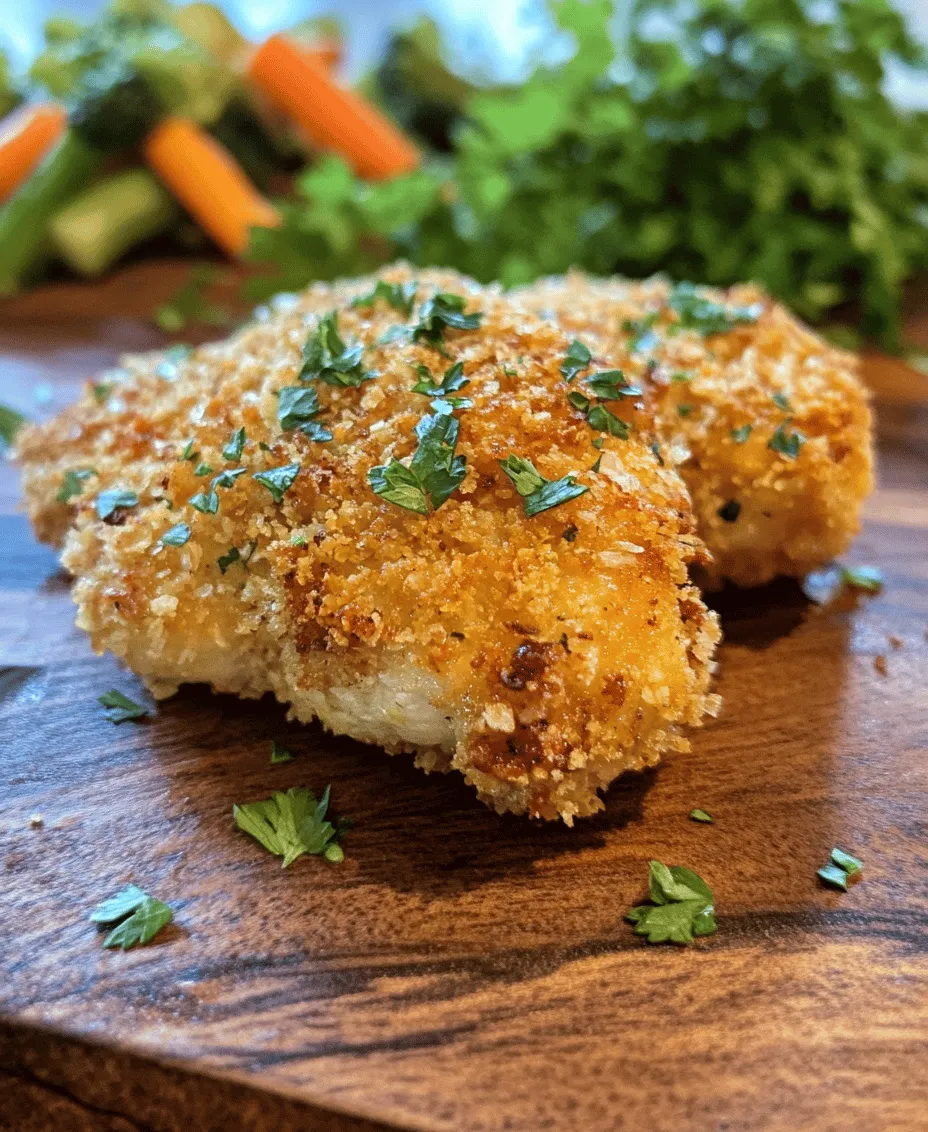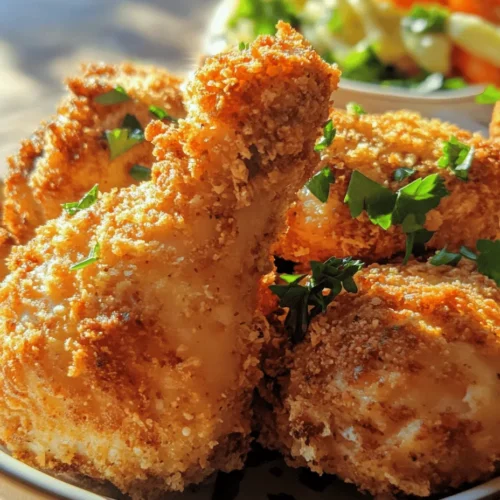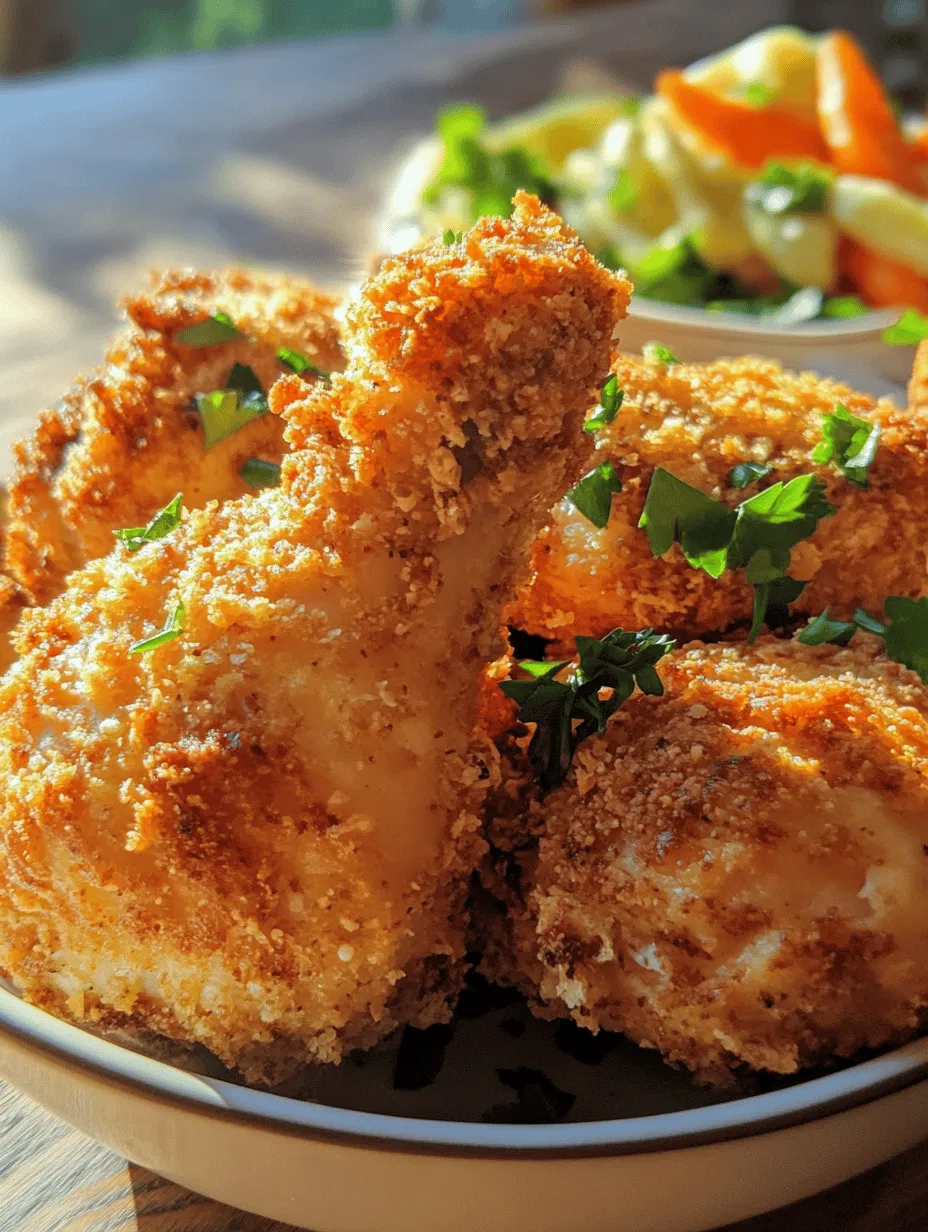Introduction
In the realm of comfort food, few dishes can rival the savory delight of Parmesan Crusted Chicken. Renowned for its crispy exterior and juicy, tender chicken, this dish has earned a special place on the menu of many beloved restaurants, including Longhorn Steakhouse. Now, you can recreate that restaurant experience right in your own kitchen with this easy copycat recipe. Perfect for family dinners or impressing guests, the Longhorn Parmesan Crusted Chicken combines the rich flavors of Parmesan cheese with Italian seasoned breadcrumbs, creating a crust that is as satisfying as it is delicious.
Imagine biting into a perfectly baked chicken breast, the crunch of the golden crust giving way to the succulent meat inside. This recipe transcends ordinary dinner fare, offering a gourmet experience that is surprisingly simple to make. Whether you’re an experienced cook or a kitchen novice, this guide will walk you through every step of the process to ensure your chicken turns out perfectly every time.
The beauty of this Parmesan Crusted Chicken lies not just in its taste but also in its versatility. It pairs beautifully with a variety of sides, making it a flexible option for any meal. From fresh salads to creamy mashed potatoes, you can tailor your plate to suit any occasion. Moreover, the wholesome ingredients used in this recipe allow you to enjoy a comforting dish without compromising on quality.
Let’s delve into the key components of this dish, starting with an overview of the essential ingredients that come together to create this flavorful masterpiece.
Understanding the Ingredients
Overview of Chicken Breasts
At the heart of this recipe is the chicken breast, a lean cut of meat that cooks quickly and absorbs flavors well. When selecting chicken breasts for your Parmesan Crusted Chicken, look for boneless, skinless varieties to simplify the preparation process. These cuts are not only healthier but also offer a neutral base that allows the rich flavors of the Parmesan and seasonings to shine through. For the best results, choose chicken that is fresh, without any visible bruises or discoloration.
The Role of Parmesan Cheese in Flavor
Parmesan cheese is the star ingredient in this dish, providing a distinctive, nutty flavor that enhances the overall taste profile. Known for its granular texture and rich umami notes, freshly grated Parmesan will yield the best results. While pre-grated cheese can be convenient, it often contains fillers that can affect both flavor and texture. By using fresh Parmesan, you ensure that each bite of your chicken is bursting with authentic flavor.
Importance of Breadcrumbs in Creating Texture
Breadcrumbs play a crucial role in achieving the desired crispy exterior. For this recipe, Italian seasoned breadcrumbs are recommended, as they add an additional layer of flavor that complements the chicken and cheese. The combination of breadcrumbs with the Parmesan creates a delightful crunch that contrasts beautifully with the tender chicken inside. If you want to elevate the texture further, consider using panko breadcrumbs, which are larger and airier than traditional breadcrumbs, resulting in an even crunchier coating.
The Function of Flour in the Breading Process
Flour serves as the first step in the breading process, helping the egg mixture adhere to the chicken breast. It creates a light dusting that not only aids in binding but also promotes even cooking. When applying flour, make sure to coat the chicken evenly, shaking off any excess. This step is crucial to prevent the breading from clumping and ensures a smooth, crispy finish.
Eggs and Milk: The Binding Agents
Eggs and milk are essential components that act as binding agents in the breading process. When whisked together, they create a sticky mixture that helps the breadcrumbs and Parmesan cling to the chicken. The proteins in the eggs will also contribute to browning during cooking, resulting in a beautifully golden crust. For a richer flavor, consider using whole milk instead of skim, as the fat content will enhance the overall taste of the dish.
Seasonings That Enhance the Flavor Profile
Beyond the main ingredients, the seasoning mix is vital in elevating the flavor of your Parmesan Crusted Chicken. A blend of garlic powder, onion powder, salt, and pepper will provide a robust flavor that complements the cheese and breadcrumbs. You can also experiment with additional herbs such as oregano or basil for extra depth. The key is to season each layer of the chicken to build a complex, satisfying taste.
Fresh Parsley: The Finishing Touch
Finally, fresh parsley adds a burst of color and freshness to the dish. Not only is it visually appealing, but it also provides a subtle herbal note that balances the richness of the Parmesan cheese. When preparing your chicken, sprinkle chopped parsley over the finished dish for a touch of elegance that will impress your guests.
Preparing Your Kitchen for Success
Before diving into the cooking process, it’s essential to set up your kitchen for success. A well-organized workspace can make a significant difference in the efficiency and enjoyment of your cooking experience.
Essential Kitchen Tools and Equipment
To make the Longhorn Parmesan Crusted Chicken, you will need a few basic kitchen tools:
– Cutting Board: For prepping your chicken and chopping herbs.
– Meat Mallet or Rolling Pin: To pound the chicken to an even thickness, ensuring it cooks evenly.
– Three Shallow Dishes: For the flour, egg mixture, and breadcrumbs.
– Baking Sheet: To bake the chicken in the oven. Line it with parchment paper or foil for easy cleanup.
– Tongs: For flipping the chicken and transferring it from one station to another.
– Meat Thermometer: To check the internal temperature of the chicken, ensuring it’s cooked to perfection.
Importance of a Clean Workspace
A clean workspace is vital for any cooking endeavor. Before you start, make sure your countertops and tools are clean and sanitized. This not only helps in maintaining food safety but also allows you to work more efficiently without distractions. Keeping your ingredients organized and within reach will streamline the cooking process, making it easier to focus on creating a delicious meal.
Organizing Ingredients for Efficiency
Before you begin cooking, gather all your ingredients and place them in an easily accessible area. Measure out the required amounts of flour, breadcrumbs, cheese, and seasonings ahead of time. This mise en place approach not only saves time but also reduces the chances of forgetting any components during the cooking process. Lay out your chicken, the baking sheet, and your breading station in a logical order to create a smooth workflow.
Step-by-Step Instructions
Now that your kitchen is set up for success, let’s move on to the step-by-step instructions for making the perfect Longhorn Parmesan Crusted Chicken.
Preparing the Chicken: Techniques for Even Cooking
1. Pound the Chicken Breasts: Start by placing your chicken breasts between two pieces of plastic wrap or parchment paper. Using a meat mallet or rolling pin, gently pound the chicken to an even thickness of about half an inch. This ensures that the chicken cooks evenly and remains juicy throughout. Take care not to pound too hard, as you want to maintain the integrity of the meat.
2. Season the Chicken: Once the chicken is pounded, season both sides generously with salt and pepper. This simple step enhances the flavor and prepares the chicken for the breading process.
Creating the Breading Station: A Visual Breakdown
1. Set Up Your Breading Station: Arrange three shallow dishes in a line on your countertop. In the first dish, place about a cup of all-purpose flour. In the second dish, whisk together two eggs and a splash of milk until combined. In the third dish, mix one cup of Italian seasoned breadcrumbs with half a cup of grated Parmesan cheese. This assembly line method will make it easy to coat the chicken in a systematic way.
2. Coat the Chicken: Take each seasoned chicken breast and first dredge it in the flour, making sure to coat it evenly and shake off any excess. Next, dip the floured chicken into the egg mixture, allowing any excess to drip off. Finally, press the chicken into the breadcrumb and Parmesan mixture, ensuring it is fully coated. For an extra thick crust, you can repeat the egg and breadcrumb steps for a double coating.
3. Place on Baking Sheet: Once coated, transfer the breaded chicken breasts to the prepared baking sheet. Leave some space between each piece to allow for even cooking and crisping in the oven.
Now that you have the chicken prepared and the breading station set up, you are on your way to creating an unforgettable dish! In the next part of this recipe article, we will cover the cooking process, tips for achieving the perfect crust, and delicious side pairings to complete your meal. Stay tuned for more detailed steps and insights!

The Breading Process: Tips for Adhering Coatings
Successfully breading chicken is a crucial step in achieving that signature crispy, golden crust characteristic of Longhorn’s Parmesan Crusted Chicken. To ensure your coatings adhere perfectly, start with dry chicken. Pat the chicken breasts with paper towels to remove excess moisture. Moisture can cause the breading to slide off during cooking, so this step is vital.
Next, set up your breading station with three shallow dishes: one for flour, one for beaten eggs, and one for the breadcrumb mixture combined with freshly grated Parmesan cheese. Season the flour with salt, pepper, and any other desired spices to enhance the flavor.
When breading, follow this sequence: first, dredge the chicken in flour, ensuring it is evenly coated. Shake off any excess flour before dipping the chicken into the beaten eggs. The egg acts as a glue that binds the breadcrumbs to the chicken. Finally, press the chicken into the breadcrumb mixture, ensuring an even, thick coating. For extra crunch, consider double breading—repeat the egg and breadcrumb steps for an additional layer of crunchiness.
Cooking Techniques for Perfectly Fried Chicken
There are a few methods to achieve perfectly cooked Parmesan crusted chicken, but the most reliable is pan-frying. Begin by selecting a heavy-bottomed skillet or frying pan that retains heat well. Heat a generous amount of oil (about 1/4 inch deep) over medium to medium-high heat. Test the oil by dropping in a small piece of bread; if it sizzles and browns quickly, the oil is ready.
Carefully place the breaded chicken in the hot oil, being mindful not to overcrowd the pan, which can lower the oil temperature and lead to soggy chicken. Fry the chicken for about 5-7 minutes on each side, depending on the thickness of the breasts. A golden-brown color indicates that the chicken is cooking correctly.
For the best results, use a meat thermometer to ensure the chicken has reached an internal temperature of 165°F (75°C). This step is crucial not only for food safety but also for ensuring juicy chicken that doesn’t dry out. Once cooked, transfer the chicken to a plate lined with paper towels to absorb any excess oil.
Recognizing When Your Chicken is Done: Cooking Temperatures
Proper cooking temperature is essential for both taste and safety. As mentioned, the internal temperature of your chicken should reach 165°F (75°C). To check the temperature accurately, insert a meat thermometer into the thickest part of the chicken breast without touching the bone, as this can give a false reading.
If you do not have a meat thermometer, you can also check for doneness by cutting into the chicken. The juices should run clear, and the meat should no longer be pink. However, using a thermometer is the most reliable method to prevent undercooked or overcooked chicken.
Serving Suggestions
Pairing Your Parmesan Crusted Chicken with Complementary Dishes
Once your Parmesan Crusted Chicken is beautifully cooked, it’s time to think about what to serve alongside it. Complementing this rich dish with the right sides can elevate your meal to restaurant-quality dining at home.
Recommended Sides: Pasta, Salads, and Vegetables
Pasta: A light garlic and olive oil spaghetti or a creamy fettuccine alfredo can pair beautifully with the crunchy chicken. Tossing in some sautéed spinach or sun-dried tomatoes can add color and flavor.
Salads: A fresh garden salad with mixed greens, cherry tomatoes, cucumbers, and a light vinaigrette provides a refreshing contrast to the rich chicken. Alternatively, a Caesar salad with crisp Romaine, croutons, and a creamy dressing mirrors the flavors of the Parmesan crust.
Vegetables: Roasted or steamed vegetables such as asparagus, green beans, or zucchini can add a healthy touch. Drizzle them with olive oil and season with salt and pepper for an easy side that complements the chicken nicely.
Creative Serving Ideas: Presentation Matters
Presentation can make a significant difference in how a dish is perceived. Consider serving your Parmesan Crusted Chicken on a warm plate, garnished with fresh herbs like parsley or basil for a pop of color. A wedge of lemon can also add a zesty touch. Serving the chicken atop a bed of pasta or alongside a colorful salad can enhance visual appeal and create a more inviting meal.
Wine Pairings to Elevate Your Meal
To elevate your dining experience, consider pairing your meal with the right wine. A crisp white wine, such as a Chardonnay or Sauvignon Blanc, can complement the richness of the Parmesan. If you prefer red wine, a light Pinot Noir can provide a nice balance without overpowering the dish.
Nutritional Information
Understanding the health aspects of your Parmesan Crusted Chicken can help you make informed choices for yourself and your family.
Overview of Calories and Macronutrients
A serving of Parmesan Crusted Chicken typically contains around 400-500 calories, depending on the portion size and the amount of oil used in frying. In terms of macronutrients, you can expect approximately 25-30 grams of protein, 20-30 grams of fat, and minimal carbohydrates.
Evaluating the Dish for Dietary Restrictions
While this dish is a crowd-pleaser, it may not fit all dietary restrictions. Those with gluten intolerance should substitute regular breadcrumbs with gluten-free options. Additionally, if you are watching your calorie intake, consider baking the chicken instead of frying for a healthier option.
Options for Healthier Ingredient Swaps
To make this dish lighter, you can use skinless chicken breasts, reduce the amount of cheese in the breadcrumb mixture, or substitute olive oil for frying with an air fryer method or a light spray of cooking oil. These small adjustments can significantly lower the calorie count without sacrificing flavor.
Common Mistakes to Avoid
To ensure your cooking success, be aware of these common pitfalls.
Common Pitfalls in the Breading Process
One common mistake is not adequately seasoning the flour. Flour that lacks seasoning can lead to bland chicken. Always season each layer to enhance the overall flavor.
Avoiding Overcrowding the Pan
Overcrowding the pan is another frequent mistake that can result in uneven cooking. Always leave enough space between the pieces of chicken to allow for proper heat circulation. This will help achieve that perfect crispy crust.
Tips for Preventing Dry Chicken
To prevent dry chicken, avoid overcooking by keeping an eye on the cooking time and checking the internal temperature regularly. Chicken breasts can dry out quickly, so using a meat thermometer is the best way to ensure juicy, tender meat.
Conclusion
Bringing the Flavors of the Restaurant to Your Home Kitchen
Parmesan Crusted Chicken is not just a dish; it’s an experience that can be enjoyed by family and friends alike. With its delightful crunch and savory taste, this recipe is sure to become a staple in your culinary repertoire. By following the steps outlined in this guide, you can create a satisfying meal that showcases your cooking skills and pleases the palate. Enjoy the process, savor the flavors, and relish the joy of sharing this delicious dish with those you love. Whether it’s a family dinner or a gathering with friends, this Parmesan Crusted Chicken will surely impress and delight.



